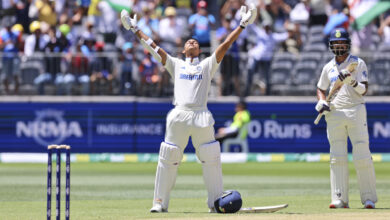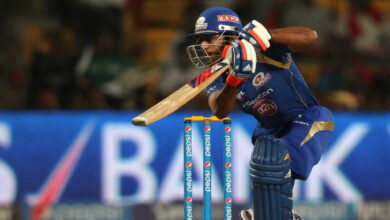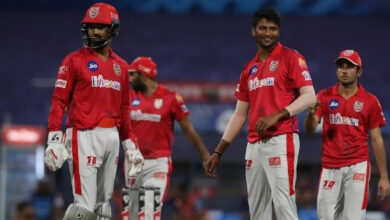Stefanos Tsitsipas tasked with Mission Impossible – stopping Novak Djokovic at the Australian Open

Novak Djokovic is 40 matches unbeaten in Australia. His 27-match-winning streak at the Australian Open is now an all-time record. He has not dropped more than eight games in each of his last three straight-sets wins.
And now, as he takes on Stefanos Tsitsipas in the final, there is more than just a Grand Slam title at stake.
The Serb is vying for a record-extending 10th singles title in Melbourne, which will equal Rafael Nadal’s all-time Major record of 22. Tsitsipas, after reaching the semifinal at three of the last four Australian Opens, is in his first Major final. The winner is also confirmed to usurp the World No. 1 spot from Carlos Alcaraz in the rankings.
For Djokovic, though, this match is the culmination of a redemption arc following one of the most bizarre and polarising storylines in modern sport. The Serb’s decision to refuse to get vaccinated against Covid-19, and his deportation from Australia last year has led to plenty of detractors, and also a battle with the media with him claiming that he has incorrectly been portrayed as a “villain of the world”.
The dractions have piled up. His entire campaign this fortnight has been under the shadow of a hamstring injury, due to which he has not been practising in between matches, and there have been some – to Djokovic’s evident scorn – who have questioned the legitimacy of the injury.
Then come the optics of what took place on Wednesday night. The Serb’s father, Srdjan, was not present in his box for his semifinal win against Tommy Paul after he was filmed with Vladimir Putin supporters outside the stadium in demonstrations that were meant to be banned in Melbourne Park. A clarification came from the Djokovic clan soon after, but he admitted to being affected the negative attention.
In the background of all that external strife, Djokovic has shown his trademark steel on court, his form full of menace and fury as he has used the storm surrounding his polarising public personality to fuel his fire and produce some of his most commanding tennis.
Tsitsipas has the small challenge of doing what nobody has been able to do since Hyeon Chung in 2018 – beating Djokovic in Melbourne.
Serve & forehand combination
Much of the reason why Djokovic has always had an upper hand on Tsitsipas – he has won 10 of their previous 12 encounters – is because he nullifies the Greek’s strengths.
Tsitsipas bases his game on a powerful and versatile serve that allows him to stay in sets and take them to tiebreakers, even when he is not at his best. At this tournament, he has held serve 92 per cent of the time, and has won 84 per cent of the points on his first serve, making him the most reliable server in the men’s draw.
Explained The Longer Exchanges Despite the 7-5, 6-1, 6-2 scoreline, Tommy Paul managed to make life difficult for Djokovic in the semifinal – especially in the first set when the Serb blew a 5-1 lead – elongating the rallies. He won more points (16) than Djokovic (12) when the rallies lasted longer than 9 shots, a stat that seems impossible given the legacy of incredible baseline defence that Djokovic has created over the past decade. But on Friday, in the breeze of the cool, night conditions, and troubled his hamstring, Djokovic went through a physical lapse, with his movement slightly restricted. Paul clocked in on that, and himself a great mover, began making Djokovic work harder for points, moving him side-to-side and elongating the rallies to force hasty errors, winning four games in a row. For all the talk about Djokovic’s hamstring injury, Paul was the first player since the second round that actually tested it. Tsitsipas may take a page out of the American’s book, and contrary to how he has approached his matchup with Djokovic in the past, may use his forehand to move the Serb more, and extend the length of the rallies, to take advantage of his superior physical condition.
But there is no player better at dealing with big servers than Djokovic, who is arguably the greatest returner in the hory of the game. He is able to rob opponents of momentum and time through varying return positioning, and being able to hit them both deep and wide, giving him an array of options to neutralise Tsitsipas’ serving threat.
A big serve allows Tsitsipas to get his forehand into play, on which he applies spin and depth. But without needing to constantly compete on the forehand, Djokovic is able to bring his legendary backhand into play, which he can relentlessly hit crosscourt to push Tsitsipas wider and wider on his weaker one-handed backhand, either forcing an error or opening up the court for himself to take command of the rallies.
Tsitsipas will need both his serve and forehand to be in top form to be able to compete, especially to give himself a good start, before his more experienced opponent clocks in on his weaknesses.
More than anything, this will be a tough mental test for the Greek. He has so many shots in his tennis repertoire, a well-formed technique, and is coming into the peak of his physical conditioning. Here, he has another chance to prove that the mental lapses that have cost him in the past, do not come in the way again. A win on Sunday – as unlikely as it may currently seem – would be a huge statement.







